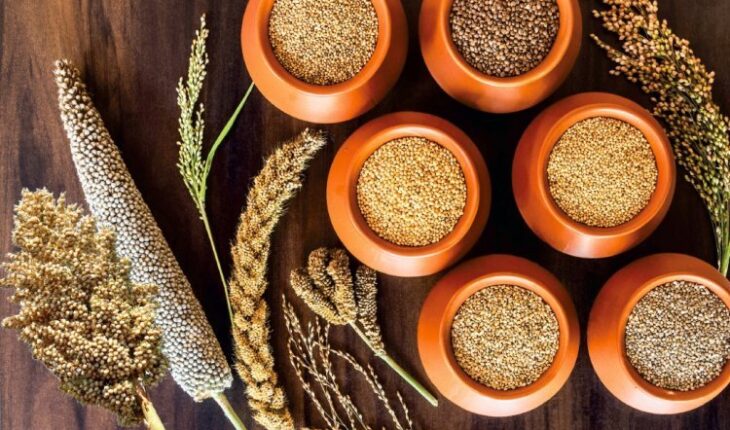
At the request of the government of India, the United Nations is celebrating 2023 as the International Millet year and the government of India are actively promoting the production of millet. 72 countries supported the proposal of India and the United Nations General Assembly (UNGA) declared 2023 as the International Year of Millets. Now, the Government of India has decided to celebrate IYOM, 2023 to make it a people’s movement so that Indian millets, recipes, and value-added products are accepted globally. The govt’s action plan focuses on strategies to enhance millet production, consumption, export, and branding. Millets are a group of small-seeded grasses that are widely grown as food crops in various parts of the world. In recent years, millets have gained popularity due to their nutritional value, especially in areas where people have limited access to food. Recently honourable P.M. has given it the name “Shree Ann”.
Haryana is one of the states in India where millet is grown, and the government has taken several measures to promote its production. Haryana is primarily an agricultural state, and its economy is heavily dependent on the agriculture sector. Millets are grown in various parts of the state, including the districts of Karnal, Panipat, Jind, and Kaithal. MILLETS, including bajra and jowar, are among the theKhariff crops grown in dry and semi-dry areas of Mahendragarh, Bhiwani, Gurgaon, Hisar, Rohtak, Jhajjar, and Rewari districts of Haryana. A project of Rs 27 crore is being prepared to promote the cultivation of millets in Haryana in 2023.
According to Agriculture Department figures, Haryana has 483.1 hectares under bajra during 2021-22. Jowar is sown mainly as fodder for cattle. A report by Chaudhary Charan Singh Haryana Agricultural University (HAU), Hisar, mentions that the area under bajra has shown a decreasing trend even though its productivity has improved with the adoption of hybrid seeds. Bajra production fluctuates, depending upon the quantum of precipitation as large areas are confined to rainfed conditions. The HAU report states that bajra’s average net returns in Haryana are Rs 1,336 per acre. millets were traditionally consumed across India, but due to the push given to food security during the Green Revolution in the 1960s, these were rendered ‘orphaned crops’. Before the Green Revolution, millets made up around 40% of all cultivated grains; this share has dropped to around 20% over the years, compromising agricultural, nutritional, and environmental concerns. Its consumption and sowing area have declined, with farmers shifting to commercial crops, oilseeds, pulses, and maize. These crops are profitable and their production is supported by several policies through subsidized inputs, incentivized procurement, and inclusion in the public distribution system. This has resulted in changes in dietary patterns with preferential consumption towards calorie-rich cereals, adding that due to reduced focus, millets suffered on the R&D front. The government of Haryana has taken several measures to promote the production of millet in the state. The government provides subsidies to farmers for the purchase of millet seeds, fertilizers, and machinery. This helps to reduce the cost of cultivation and encourages farmers to grow more millets. The government conducts training programs for farmers to educate them about the benefits of growing millets and the latest cultivation techniques. These programs are aimed at improving the productivity and quality of millet crops. The government provides financial assistance to farmers who grow millets under the Rashtriya Krishi Vikas Yojana (RKVY) and the National Food Security Mission (NFSM). This helps to promote the production of millet and improve the livelihoods of farmers. The government is promoting the use of millet in various food products, including biscuits, bread, and porridge. This helps to create a market for millets and increases their demand. The government is setting up millet clusters in various parts of the state to promote the production of millet. These clusters provide farmers with access to seeds, machinery, and other inputs, as well as markets for their produce.
Millets are rich in nutrients and can help to address malnutrition and food insecurity in the state. The promotion of millet production can help to improve the nutritional status of the population, especially in rural Haryana. Millets are drought-resistant crops and are well-suited to the semi-arid climate of Haryana. The promotion of millet production can help to increase the resilience of the agriculture sector to climate change and drought. The promotion of millet production can help to generate income for farmers, especially in areas where other crops are not viable. Millets can be grown on marginal lands and require less water and fertilizer. According to data from the Directorate of Agriculture and Farmers Welfare, Haryana, the production of millet in the state has been on the rise in recent years.
The production of millet, especially pearl millet, has been increasing steadily in Haryana. The government’s efforts to promote millet production through subsidies, training programs, financial assistance, and promotion of millet-based products seem to be paying off. Millets are an essential crop for Haryana’s agricultural economy, and their products can help improve the population’s nutritional status and generate income for farmers. we need to make people aware of the nutritional richness of millet. Their consumption can be increased by setting up processing units at the village level.
Dr.Harvinder Kaur, Associate Professor in Economics, Ambala, views are personal





